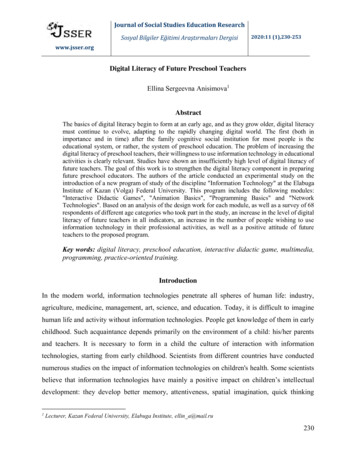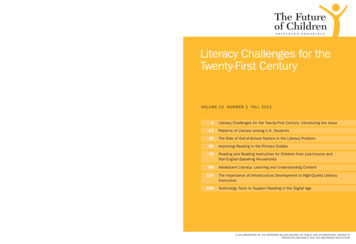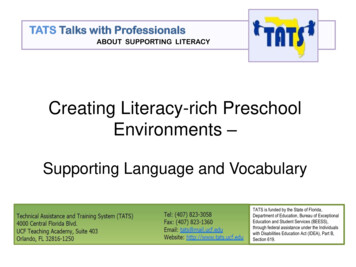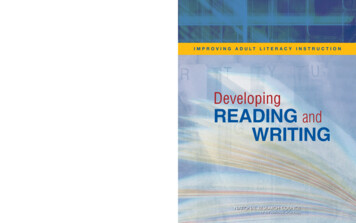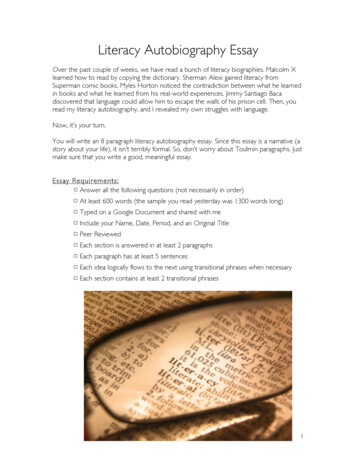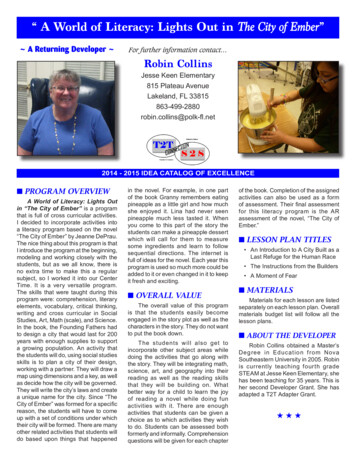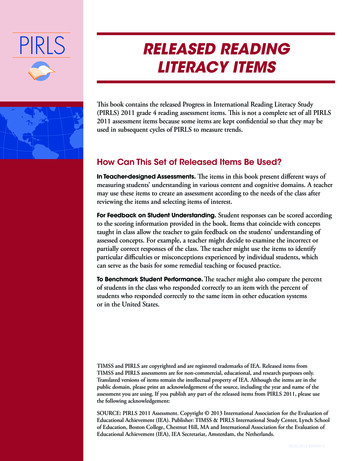
Transcription
RELEASED READINGLITERACY ITEMSThis book contains the released Progress in International Reading Literacy Study(PIRLS) 2011 grade 4 reading assessment items. This is not a complete set of all PIRLS2011 assessment items because some items are kept confidential so that they may beused in subsequent cycles of PIRLS to measure trends.How Can This Set of Released Items Be Used?In Teacher-designed Assessments. Theitems in this book present different ways ofmeasuring students’ understanding in various content and cognitive domains. A teachermay use these items to create an assessment according to the needs of the class afterreviewing the items and selecting items of interest.For Feedback on Student Understanding. Studentresponses can be scored accordingto the scoring information provided in the book. Items that coincide with conceptstaught in class allow the teacher to gain feedback on the students’ understanding ofassessed concepts. For example, a teacher might decide to examine the incorrect orpartially correct responses of the class. The teacher might use the items to identifyparticular difficulties or misconceptions experienced by individual students, whichcan serve as the basis for some remedial teaching or focused practice.To Benchmark Student Performance. Theteacher might also compare the percentof students in the class who responded correctly to an item with the percent ofstudents who responded correctly to the same item in other education systemsor in the United States.TIMSS and PIRLS are copyrighted and are registered trademarks of IEA. Released items fromTIMSS and PIRLS assessments are for non-commercial, educational, and research purposes only.Translated versions of items remain the intellectual property of IEA. Although the items are in thepublic domain, please print an acknowledgement of the source, including the year and name of theassessment you are using. If you publish any part of the released items from PIRLS 2011, please usethe following acknowledgement:SOURCE: PIRLS 2011 Assessment. Copyright 2013 International Association for the Evaluation ofEducational Achievement (IEA). Publisher: TIMSS & PIRLS International Study Center, Lynch Schoolof Education, Boston College, Chestnut Hill, MA and International Association for the Evaluation ofEducational Achievement (IEA), IEA Secretariat, Amsterdam, the Netherlands.38332.0513.86070412
USER’S GUIDEThis book contains PIRLS 2011 released passagesand items for grade 4. Following the passage, eachitem appears on a single page, on which is providedinformation about the item’s classification and aboutinternational student performance on the item. Theitems appear in the passage order, as shown in theindex on the next page.Information aboutitem classificationTake a look at the first item on page 6. Across thetop are three boxes which identify the passage,its reading purpose (the specific topic assessedwithin that subject matter), and its comprehensionprocess (the cognitive or thinking processassessed). For this item, the passage is The GiantTooth Mystery, the reading purpose is acquire anduse information, and the comprehension process isfocus on and retrieve explicitly-stated information.Below the row of boxes and above a boxed-in areaof the page is the item label. For this item, it isItem 1: What is a fossil. Below the boxed-in area isthe variable name, which is more commonly usedto identify each item than the item label.Correct answers are shown beneath each item.The correct answer for multiple-choice items issimply a letter code. For example, in the itemR0321G01M on page 6, the letter code C is thecorrect answer. The correct answers for write-inor open-ended items are explained in a scoringguide. For example, the item 2: Why people believedin giants (page 7) provides an example of a scoringguide, indicating the general nature of correct andincorrect responses. In some cases, partial credit maybe awarded and these items will provide guidelinesfor fully correct, partially correct, and incorrectresponses. Sample student responses are providedfor some of the constructed-response items for eachscoring category.Information about internationalstudent performanceIn the table along the right-hand side of the pageare the percent correct statistics for the item.These consist of statistics on the percentage ofstudents in each participating education systemwho could answer the question correctly. The listsof education systems are ordered in terms of thispercentage. The international average is includedas well.To the right of some of the percent correctstatistics are special symbols that indicate whenan education system scored significantly higher orsignificantly lower than the international average.Thus, on the item What is a fossil as an example,an estimated 85 percent of U.S. students couldcorrectly answer this item, a percentage that wasmeasurably higher than the international average,after taking into account the standard of errorassociated with the percent correct statistic for theUnited States and for the international average.38332.0513.86070412
ITEM INDEXPassageLevelPageIntermediate (475)High (550)High (550)Advanced (625)Advanced (625)High (550)High (550)Above AdvancedHigh (550)Advanced (625)High (550)Above AdvancedAdvanced (625)Advanced (625)6791012131415181921222427Giant CR031G13CR031G14MWhat is a fossilWhy people believed in giantsWhere Palissy found fossilsWhat was Palissy’s new ideaWhy Palissy was imprisonedWho found the fossil toothWhat made the tooth puzzlingTooth from diff. types (DERIVED)Why Gideon took tooth to a museumWhy seeing tooth was importantWhat Gideon usedPurpose of two Iguanodon picturesHow Iguanodon looked (DERIVED)What discovery proved Gideon wrongEnemy 031P13MR031P14CR031P15CR031P16CWho is telling the storyWhy Tom thought Jeremy was enemyAn ingredient in the pieWhy Tom thought be a good summerHow Tom felt after smelling pieWhat Tom thought would happenThings Tom’s dad told for pieWhy Tom went to Jeremy’s houseWhat surprises TomWhy T. didn’t want to go with planHow Tom felt when Jeremy took pieWhat was Dad’s secretWhat sentence suggest about boysWhy Tom’s dad made the pieWhat type of person is Tom’s dadWhat is the lesson of the storyHigh (550)Intermediate (475)Intermediate (475)Advanced (625)Advanced (625)Intermediate (475)High (550)Intermediate (475)Intermediate (475)Intermediate (475)High (550)High (550)Intermediate (475)High (550)Advanced (625)Advanced 070412
ITEM INDEXPassageLevelPageIntermediate (475)Intermediate (475)Advanced (625)High (550)Intermediate (475)Intermediate (475)High (550)High (550)High (550)High (550)High (550)High (550)596062646566676870717274Low (400)High (550)Intermediate (475)Intermediate (475)High (550)High (550)High (550)Advanced (625)Above AdvancedHigh (550)High (550)Advanced (625)848586878890919394969899Day 2CMain message of the leafletWhat you see on a hikeHiking in a groupSection about right clothesWhy take extra socksWhat to do if you’re in troubleHow to avoid tiring too soonTell when you plan to returnWhich route for the shortest hikeWho could go to Lookout StationStudying the map keyReasons for choosing routeFly Eagle hat farmer set out to look forWhere farmer found eagle chickWhat shows farmer was carefulWhat farmer did with the chickEagle chick behaved like a chickenHow friend tried making eagle flyExplanation of friend’s wordsWhy farmer roared with laughterEagle taken to the high mountainsBeautiful sky at dawnWhy sun rising was importantWhat farmer’s friend was like38332.0513.86070412
PIRLS 2011 Reading Passages and ItemsTheThe GiantGiant ToothTooth MysteryMysteryTheGIANT ToothMysteryA fossil is the remains of any creature or plant that lived on theEarth many, many years ago. People have been finding fossilsfor thousands of years in rocks and cliffs and beside lakes.Wenow know that some of these fossils were from dinosaurs.Long ago, people who found huge fossils did not know what they were.Some thought the big bones came from large animals that they had seen orread about, such as hippos or elephants. But some of the bones people foundwere too big to have come from even the biggest hippo or elephant. Theseenormous bones led some people to believe in giants.Copyright 2013 International Association for the Evaluation of Educational Achievement (IEA).1
PIRLS 2011 Reading Passages and ItemsThe Giant Tooth MysteryHundreds of years ago in France, a man named Bernard Palissy hadanother idea. He was a famous pottery maker. When he went to make hispots, he found many tiny fossils in the clay. He studied the fossils and wrotethat they were the remains of living creatures. This was not a new idea.But Bernard Palissy also wrote that some of these creatures no longer livedon earth. They had completely disappeared. They were extinct.Was Bernard Palissy rewarded for his discovery? No! He was put inprison for his ideas.As time went by, some people became more open to new ideas abouthow the world might have been long ago.Then, in the 1820s, a huge fossil tooth was found in England. It isthought that Mary Ann Mantell, the wife of fossil expert Gideon Mantellwas out for a walk when she saw what looked like a huge stone tooth.Mary Ann Mantell knew the big tooth was a fossil, and took it home toher husband.When Gideon Mantell first looked at the fossil tooth, he thought ithad belonged to a plant eater because it was flat and had ridges. It wasworn down from chewing food. Itwas almost as big as the tooth of anelephant. But it looked nothing likean elephant’s tooth.Fossil tooth sketched life-sizedCopyright 2013 International Association for the Evaluation of Educational Achievement (IEA).2
PIRLS 2011 Reading Passages and ItemsThe Giant Tooth MysteryGideon Mantell could tell that the pieces of rock attached to the toothwere very old. He knew that it was the kind of rock where reptile fossilswere found. Could the tooth have belonged to a giant, plant-eating reptilethat chewed its food? A type of reptile that no longer lived on earth?Gideon Mantell was really puzzled by the big tooth. No reptile that heknew about chewed its food. Reptiles gulped their food, and so their teethdidn’t become worn down. It was a mystery.Gideon Mantell took the tooth to a museum in London and showed itto other scientists. No one agreed with Gideon Mantell that it might be thetooth of a gigantic reptile.Gideon Mantell tried to find a reptile that had a tooth that looked likethe giant tooth. For a long time, he found nothing. Then one day he meta scientist who was studying iguanas. An iguana is a large plant-eatingreptile found in Central and South America. It can grow to be more thanfive feet long. The scientist showed Gideon Mantell an iguana tooth. At last!Here was the tooth of a living reptile that looked like the mystery tooth.Only the fossil tooth was much, much bigger.IguanaA life-sizeddrawing of aniguana’s toothfrom Gideon Mantell’snotebookCopyright 2013 International Association for the Evaluation of Educational Achievement (IEA).3
PIRLS 2011 Reading Passages and ItemsThe Giant Tooth MysteryNow Gideon Mantell believed the fossil tooth had belonged to ananimal that looked like an iguana. Only it wasn’t five feet long. GideonMantell believed it was a hundred feet long! He named his creatureIguanodon. That means “iguana tooth”.Gideon Mantell did not have a whole Iguanodon skeleton. But fromthe bones he had collected over the years, he tried to figure out what onemight have looked like. He thought the bones showed that the creature hadwalked on all four legs. He thought a pointed bone was a horn. He drew anIguanodon with a horn on its nose.What Gideon Mantell thought an Iguanodon looked likeCopyright 2013 International Association for the Evaluation of Educational Achievement (IEA).4
PIRLS 2011 Reading Passages and ItemsThe Giant Tooth MysteryYears later, several complete Iguanodon skeletons were found. Theywere only about thirty feet long. The bones showed that it walked on itshind legs some of the time. And what Gideon Mantell thought was a hornon its nose was really a spike on its “thumb”! Based on these discoveries,scientists changed their ideas about what the Iguanodon looked like.Gideon Mantell made some mistakes. But he had made animportant discovery, too. Since his first idea that the fossiltooth belonged to a plant-eating reptile, he spent manyyears gathering facts and evidence to prove hisideas were right. By making careful guessesalong the way, Gideon Mantell was one ofthe first people to show that long ago,giant reptiles lived on earth. Andthen they became extinct.Hundreds of yearsbefore, Bernard Palissyhad been thrown in prisonfor saying nearly the samething. But Gideon Mantellbecame famous. His discoverymade people curious to findout more about these hugereptiles.What scientists today think the IguanodonIn 1842, a scientist namedlooked likeRichard Owen decided that these extinct reptiles needed a name of theirown. He called them Dinosauria. This means “fearfully great lizard”. Todaywe call them dinosaurs.Copyright 2013 International Association for the Evaluation of Educational Achievement (IEA).5
PIRLS 2011 Reading Passages and ItemsPassageReading PurposeTHE GIANT TOOTH MYSTERYAcquire and Use InformationItem 1: What is a fossil1.Comprehension Process ofthe TaskFocus on and Retrieve ExplicitlyStated InformationOverall Percent CorrectPercentcorrectWhat is a fossil?Education systemA.the surface of rocks and cliffsB.the bones of a giantC.the remains of very old living thingsD.the teeth of elephantsNetherlandsItalyHong Kong-CHNSwedenSpainFinlandSloveniaIsraelChinese Taipei-CHNCroatiaUnited StatesGermanyHungaryEngland-GBRNorthern Ireland-GBRGeorgiaRussian rtugalRomaniaBulgariaNew ZealandNorwayDenmarkCzech RepublicInternational averageSingaporeSlovak RepublicPolandIndonesiaBelgium (French)-BELFranceMaltaUnited Arab EmiratesQatarTrinidad and TobagoAzerbaijanIran, Islamic Rep. ofColombiaSaudi 251494542Benchmarkingeducation systemPercentcorrectVariable Name: R031G01MCorrect io-CANQuebec-CANMaltese-MLTDubai-UAEAbu Dhabi-UAE9389878378736858Percent higher than International averagePercent lower than International averageCopyright 2013 International Association for the Evaluation of Educational Achievement (IEA).6
PIRLS 2011 Reading Passages and ItemsPassageReading PurposeComprehension Process ofthe TaskTHE GIANT TOOTH MYSTERYAcquire and Use InformationMake Straightforward InferencesItem 2: Why people believed in giants2.Overall Percent CorrectAccording to the article, why did some people long ago believe ingiants?Variable Name: R031G02CSCORING1 - Acceptable Response The response demonstrates understanding that people long ago believed in giants becausethey found huge bones/skeletons/fossils.Examples:They found bones too big to belong to something they knew.They found giant bones that were too big to be from the biggest hippo.They found really big bones.0 - Unacceptable Response The response does not demonstrate understanding that people long ago believe in giantsbecause they found huge bones/skeletons/fossils.Examples:Giants are really big.They found dinosaur bones.They found things that must belong to giants.Education systemPercentcorrectSingaporeChinese Taipei-CHNHong Kong-CHNNetherlandsSwedenGermanyPortugalRussian FederationEngland-GBRNorthern ariaSlovak RepublicCzech RepublicItalyNew ceInternational averageNorwayGeorgiaFinlandUnited StatesSaudi ArabiaPolandTrinidad and TobagoQatarIndonesiaRomaniaBelgium (French)-BELUnited Arab EmiratesIran, Islamic Rep. ion MLTAndalusia-ESPFlorida-USADubai-UAEQuebec-CANAbu Dhabi-UAE6158525251494532Percent higher than International averagePercent lower than International averageCopyright 2013 International Association for the Evaluation of Educational Achievement (IEA).7
PIRLS 2011 Reading Passages and ItemsItem 2: Why people believed in giants (continued)Variable Name: R031G02CStudent ResponsesCorrect Response:Incorrect Response:Copyright 2013 International Association for the Evaluation of Educational Achievement (IEA).8
PIRLS 2011 Reading Passages and ItemsPassageReading PurposeTHE GIANT TOOTH MYSTERYAcquire and Use InformationItem 3: Where Palissy found fossils3.Comprehension Process ofthe TaskFocus on and Retrieve ExplicitlyStated InformationOverall Percent CorrectPercentcorrectWhere did Bernard Palissy find fossils?Education systemA.on the cliffsB.in the clayC.by a riverD.on a pathCroatiaHong Kong-CHNSingaporeIrelandFinlandNorthern Ireland-GBRPortugalUnited StatesDenmarkRussian FederationGermanySloveniaEngland-GBRCzech RepublicItalySwedenChinese n, Islamic Rep. ofRomaniaNew ZealandBulgariaAustraliaNorwayInternational averageMaltaLithuaniaPolandSlovak RepublicAzerbaijanSpainFranceGeorgiaUnited Arab EmiratesTrinidad and TobagoQatarSaudi ArabiaBelgium ion systemPercentcorrectVariable Name: R031G03MCorrect CANDubai-UAEAndalusia-ESPMaltese-MLTAbu Dhabi-UAE8180767472696558Percent higher than International averagePercent lower than International averageCopyright 2013 International Association for the Evaluation of Educational Achievement (IEA).9
PIRLS 2011 Reading Passages and ItemsPassageReading PurposeComprehension Process ofthe TaskTHE GIANT TOOTH MYSTERYAcquire and Use InformationInterpret and Integrate Ideas andInformationItem 4: What was Palissy’s new idea4.Overall Percent CorrectWhat was Bernard Palissy’s new idea?Education systemVariable Name: R031G04CSCORING1 - Acceptable Response The response demonstrates understanding that Palissy’s new idea was that some fossilsbelonged to animals that no longer lived on earth, had completely disappeared, or were extinct.Examples:Fossils could be from extinct animals.Some belonged to creatures no longer living on earth.His idea was that some animals completely disappeared!0 - Unacceptable Response The response does not demonstrate understanding of Palissy’s new idea. It might relate toPalissy’s idea that fossils once belonged to living creatures, or may state a fact about Palissy’swork.Examples:Fossils were from the remains of living creatures.Reptiles were extinct.He found fossils in his clay.PercentcorrectHong Kong-CHNChinese Taipei-CHNRussian FederationSingaporeHungaryCzech RepublicFinlandSlovak RepublicNorthern CroatiaBulgariaIrelandSloveniaCanadaInternational averageIran, Islamic Rep. ofNetherlandsUnited iaQatarSaudi ArabiaAustriaGeorgiaMaltaNew ZealandNorwayFranceUnited Arab EmiratesOmanTrinidad and TobagoPolandSpainMoroccoBelgium 71716151514121211119Benchmarkingeducation CANQuebec-CANDubai-UAEAbu ercent higher than International averagePercent lower than International averageCopyright 2013 International Association for the Evaluation of Educational Achievement (IEA).10
PIRLS 2011 Reading Passages and ItemsItem 4: What was Palissy’s new idea (continued)Variable Name: R031G04CStudent ResponsesCorrect Response:Incorrect Response:Copyright 2013 International Association for the Evaluation of Educational Achievement (IEA).11
PIRLS 2011 Reading Passages and ItemsPassageReading PurposeTHE GIANT TOOTH MYSTERYAcquire and Use InformationItem 5: Why Palissy was imprisoned5.People were not open to new ideas.B.He copied his ideas from Gideon Mantell.C.He left tiny fossils in his pottery.D.Studying fossils was forbidden in France.Education systemVariable Name: R031G05MCorrect Response:Make Straightforward InferencesOverall Percent CorrectWhy was Bernard Palissy put into prison?A.Comprehension Process ofthe TaskAPercentcorrectChinese Taipei-CHNDenmarkHong Kong-CHNFinlandItalyNetherlandsIrelandCzech RepublicPortugalSingaporeEngland-GBRHungaryUnited StatesNorthern Ireland-GBRBulgariaSwedenCanadaSlovak RepublicIsraelAustriaNew ZealandRussian FederationAustraliaCroatiaSpainInternational averageGermanyGeorgiaRomaniaPolandNorwayIran, Islamic Rep. ofLithuaniaFranceUnited Arab EmiratesMaltaBelgium (French)-BELSaudi ArabiaAzerbaijanIndonesiaQatarOmanSloveniaTrinidad and 2424039383532Benchmarkingeducation ANAndalusia-ESPAlberta-CANDubai-UAEMaltese-MLTAbu Dhabi-UAE6659595656514845Percent higher than International averagePercent lower than International averageCopyright 2013 International Association for the Evaluation of Educational Achievement (IEA).12
PIRLS 2011 Reading Passages and ItemsPassageReading PurposeTHE GIANT TOOTH MYSTERYAcquire and Use InformationItem 6: Who found the fossil tooth6.Bernard PalissyB.Mary Ann MantellC.Richard OwenD.Gideon MantellEducation systemVariable Name: R031G06MCorrect Response:Focus on and Retrieve ExplicitlyStated InformationOverall Percent CorrectWho found the fossil tooth in England?A.Comprehension Process ofthe TaskBPercentcorrectRussian FederationIrelandHong Kong-CHNCroatiaSingaporeLithuaniaNorthern Ireland-GBRCzech RepublicSlovak RepublicItalyDenmarkBulgariaGermanyFinlandChinese Taipei-CHNEngland-GBRCanadaAustriaFranceUnited StatesMaltaSwedenNew tional averageSloveniaSpainBelgium (French)-BELNorwayNetherlandsTrinidad and TobagoRomaniaGeorgiaAzerbaijanUnited Arab EmiratesColombiaQatarIndonesiaIran, Islamic Rep. ofSaudi 442403729Benchmarkingeducation ANMaltese-MLTAlberta-CANAndalusia-ESPDubai-UAEAbu Dhabi-UAE7776727171686447Percent higher than International averagePercent lower than International averageCopyright 2013 International Association for the Evaluation of Educational Achievement (IEA).13
PIRLS 2011 Reading Passages and ItemsPassageReading PurposeTHE GIANT TOOTH MYSTERYAcquire and Use InformationItem 7: What made the tooth puzzling7.Reptiles had no teeth.B.Reptiles were found under rocks.C.Reptiles lived long ago.D.Reptiles gulped their food.Variable Name: R031G07MCorrect Response:Make Straightforward InferencesOverall Percent CorrectWhat did Gideon Mantell know about reptiles that made the fossiltooth puzzling?A.Comprehension Process ofthe TaskDEducation systemPercentcorrectCroatiaIrelandCzech RepublicFinlandNorthern Ireland-GBRHungaryRussian FederationEngland-GBRUnited StatesItalyDenmarkSingaporeLithuaniaSlovak RepublicSloveniaBulgariaHong Kong-CHNAzerbaijanNetherlandsCanadaIran, Islamic Rep. ofNew onal averageIsraelRomaniaBelgium (French)-BELGeorgiaFranceNorwayTrinidad and TobagoChinese Taipei-CHNPortugalMaltaUnited Arab EmiratesQatarPolandColombiaSaudi 464240393835302924Benchmarkingeducation CANAndalusia-ESPDubai-UAEQuebec-CANMaltese-MLTAbu Dhabi-UAE7367646254464236Percent higher than International averagePercent lower than International averageCopyright 2013 International Association for the Evaluation of Educational Achievement (IEA).14
PIRLS 2011 Reading Passages and ItemsPassageReading PurposeComprehension Process ofthe TaskTHE GIANT TOOTH MYSTERYAcquire and Use InformationInterpret and Integrate Ideasand InformationItem 8: Tooth from diff. types (DERIVED)8.Overall Percent CorrectGideon Mantell thought the tooth might have belonged to differenttypes of animals. Complete the table to show what made him thinkthis.Type of animalWhat made him think thisA plant eaterThe tooth was flat with ridges.A giant creatureAA reptileBVariable Name: R031G08CSCORING1 - Acceptable Response Each of the two parts of this item will be scored separately in its own 1-point coding block.Type of animalWhat made him think thisA giant creatureThe response identifies the large size of the fossil tooth (as big asan elephant’s tooth).A reptileThe response indicates that:1) the rock in which it was found was the kind of rock where reptilefossils were found/it was found where reptiles had lived. -OR2) the fossil tooth was similar to/looked like an iguana/reptiletooth.0 - Unacceptable ResponseType of animalWhat made him think thisA giant creatureThe response does not show understanding of the characteristicsthat indicate the fossil tooth could belong to a giant creature. Theresponse may refer to the text at the beginning of the passageabout fossils in general, rather than to Gideon’s hypotheses aboutthe fossil tooth.A reptileThe response does not show understanding of the characteristicsthat indicate the fossil tooth could belong to a reptile.Copyright 2013 International Association for the Evaluation of Educational Achievement (IEA).15Education systemPercentcorrectSingaporeCanadaNorthern Ireland-GBRRussian FederationPortugalEnglandIsraelUnited StatesNew ZealandCzech RomaniaBulgariaCroatiaPolandGermanyLithuaniaSlovak RepublicNetherlandsSwedenInternational averageSpainSloveniaAustriaFranceBelgium (French)-BELQatarNorwayMaltaChinese Taipei-CHNGeorgiaUnited Arab EmiratesTrinidad and TobagoHong Kong-CHNColombiaIran, Islamic Rep. ofAzerbaijanIndonesiaOmanSaudi education CANQuebec-CANDubai-UAEAndalusia-ESPMaltese-MLTAbu Dhabi-UAERounds to zero.22212019101054Percent higher than International averagePercent lower than International average
PIRLS 2011 Reading Passages and ItemsItem 8: Tooth from diff. types (DERIVED)(continued)Variable Name: R031G08CStudent ResponsesCorrect Response:Copyright 2013 International Association for the Evaluation of Educational Achievement (IEA).16
PIRLS 2011 Reading Passages and ItemsItem 8: Tooth from diff. types (DERIVED) (continued)Variable Name: R031G08CStudent ResponsesIncorrect Response:Copyright 2013 International Association for the Evaluation of Educational Achievement (IEA).17
PIRLS 2011 Reading Passages and ItemsPassageReading PurposeTHE GIANT TOOTH MYSTERYAcquire and Use InformationItem 9: Why Gideon took tooth to a museum9.Comprehension Process ofthe TaskMake Straightforward InferencesOverall Percent CorrectPercentcorrectWhy did Gideon Mantell take the tooth to a museum?Education systemA.to ask if the fossil belonged to the museumB.to prove that he was a fossil expertC.to hear what scientists thought of his ideaD.to compare the tooth with others in the museumHong Kong-CHNChinese Taipei-CHNSingaporeItalyFinlandRussian FederationSwedenPortugalCzech RepublicIrelandSloveniaEngland-GBRNorthern Ireland-GBRLithuaniaIsraelSlovak RepublicFranceCroatiaHungarySpainGermanyUnited StatesAustriaBelgium (French)-BELCanadaBulgariaDenmarkInternational New ZealandMaltaPolandGeorgiaTrinidad and TobagoIran, Islamic Rep. ofUnited Arab EmiratesQatarSaudi 52525151474646434236353126Benchmarkingeducation systemPercentcorrectVariable Name: R031G09MCorrect o-CANAlberta-CANDubai-UAEAbu Dhabi-UAEMaltese-MLT6464635954544341Percent higher than International averagePercent lower than International averageCopyright 2013 International Association for the Evaluation of Educational Achievement (IEA).18
PIRLS 2011 Reading Passages and ItemsPassageReading PurposeComprehension Process ofthe TaskTHE GIANT TOOTH MYSTERYAcquire and Use InformationInterpret and Integrate Ideas andInformationItem 10: Why seeing tooth was important10.Overall Percent CorrectA scientist showed Gideon Mantell an iguana tooth. Why was thisimportant to Gideon Mantell?Variable Name: R031G10CSCORING1 - Acceptable Response The response demonstrates understanding that the iguana tooth provided evidence thatsupported Gideon Mantell’s theory that the fossil tooth might have belonged to a giant reptile.-OR The response demonstrates a more general understanding that the iguana tooth looked likethe fossil tooth.Examples:The iguana tooth showed his fossil could be from a reptile.The tooth proved he was right.He could see that they loked the same.0 - Unacceptable Response The response does not demonstrate understanding of the significance of the iguana tooth.Examples:He wanted to be famous.He thought it would be interesting to see an iguana’s tooth.Education sys
This book contains PIRLS 2011 released passages . and items for grade 4. Following the passage, each . item appears on a single page, on which is provided . information about the item's classification and about international student performance on the item. The items appear in the passage order, as shown in the index on the next page .
